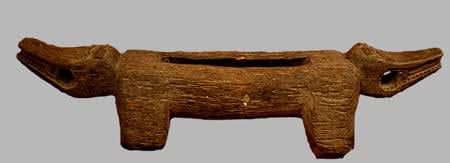Dogon Wooden Gong in the Form of a Double-Headed Animal, 19th Century CE - 20th Century CE
This enigmatic-looking zoomorphic piece was made by the Dogon people of Mali, and is either a slit gong or a commemorative sculpture. It comprises a rectangular block on four solid...
This enigmatic-looking zoomorphic piece was made by the Dogon people of Mali, and is either a slit gong or a commemorative sculpture. It comprises a rectangular block on four solid legs, the top of which is incised with a shallow depression. The finials at each end of the object are carved into the likeness of crocodile heads, their teeth bared, with eyes located atop their heads in an anatomically correct manner. The wood is very dark, patinated and sporadically glossy.
The Dogon have been described as the most studied and least understood tribal group in Africa. They live on the Bandiagara escarpment, Mali, a 150-mile-long eminence that supports a population of between 250,000 and 450,000. They moved to this area in the 15th century, escaping the Mande kingdom and slavery at the hands of Islamic groups, and displaced a number of tribes (including the Tellem and Niongom) that were living on the escarpment at the time. They are excessively prolific in terms of artistic production, not least because they have mastered all the main materials that are used in traditional African art; figures in stone, iron, bronze/copper and of course wood are all known, in addition to cave/rock painting and adaptation of more modern materials. There are around seventy-eight different mask forms still in production (in addition to numerous extinct variants), figural sculptures of males, females, nommos and unidentifiable individuals that have maternity and ancestor functions and a wide range of secular items decorated with iconographic designs that bestow benedictions upon the user or owner. The most important works are kept and manipulated by the spiritual leader (Hogon) away from the public eye, within the houses of families, or in sanctuaries. The scale of the population and the size of the area in which they live have resulted in considerable social and artistic diversity, and a complex interplay between tradition and innovation.
Animal figures usually represent sacrifices, and were placed on altars to honour spirits and deities. If a drum, it would have been used to send messages or summon groups to important social events. This is a powerful and impressive piece of Dogon sculpture. It displays well, and is a striking and attractive piece of African design.
The Dogon have been described as the most studied and least understood tribal group in Africa. They live on the Bandiagara escarpment, Mali, a 150-mile-long eminence that supports a population of between 250,000 and 450,000. They moved to this area in the 15th century, escaping the Mande kingdom and slavery at the hands of Islamic groups, and displaced a number of tribes (including the Tellem and Niongom) that were living on the escarpment at the time. They are excessively prolific in terms of artistic production, not least because they have mastered all the main materials that are used in traditional African art; figures in stone, iron, bronze/copper and of course wood are all known, in addition to cave/rock painting and adaptation of more modern materials. There are around seventy-eight different mask forms still in production (in addition to numerous extinct variants), figural sculptures of males, females, nommos and unidentifiable individuals that have maternity and ancestor functions and a wide range of secular items decorated with iconographic designs that bestow benedictions upon the user or owner. The most important works are kept and manipulated by the spiritual leader (Hogon) away from the public eye, within the houses of families, or in sanctuaries. The scale of the population and the size of the area in which they live have resulted in considerable social and artistic diversity, and a complex interplay between tradition and innovation.
Animal figures usually represent sacrifices, and were placed on altars to honour spirits and deities. If a drum, it would have been used to send messages or summon groups to important social events. This is a powerful and impressive piece of Dogon sculpture. It displays well, and is a striking and attractive piece of African design.
